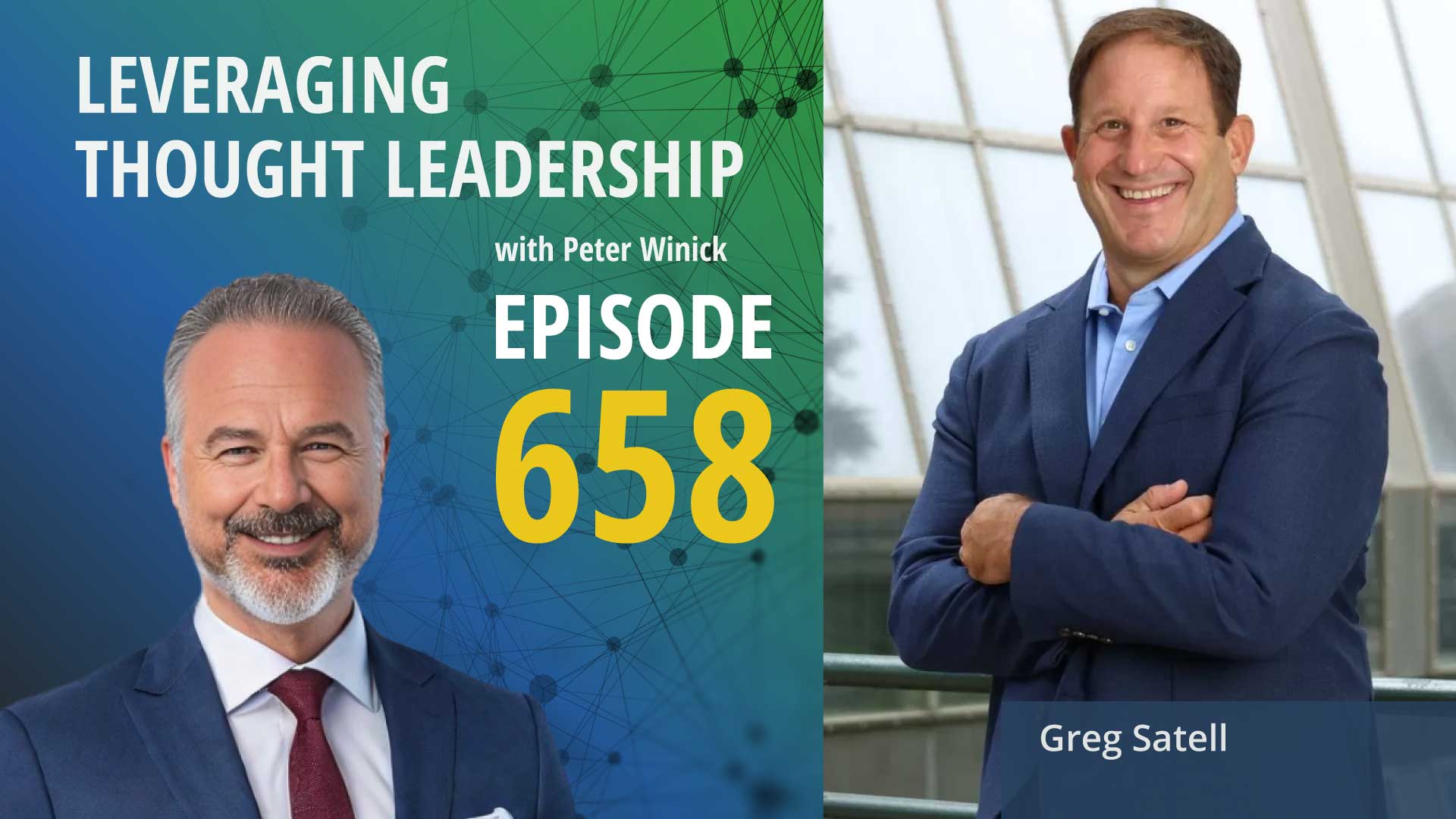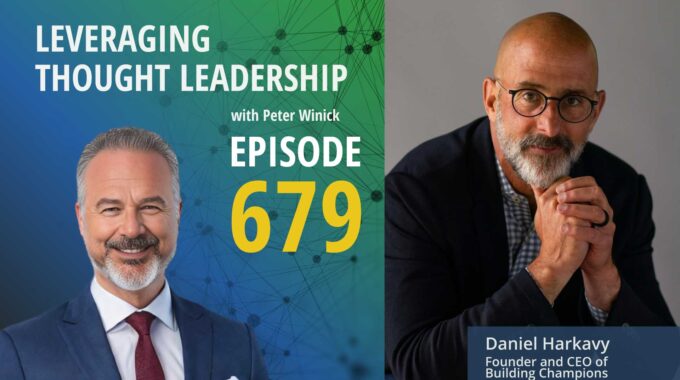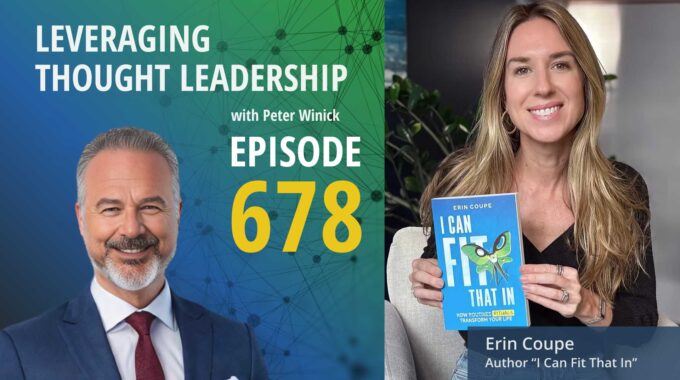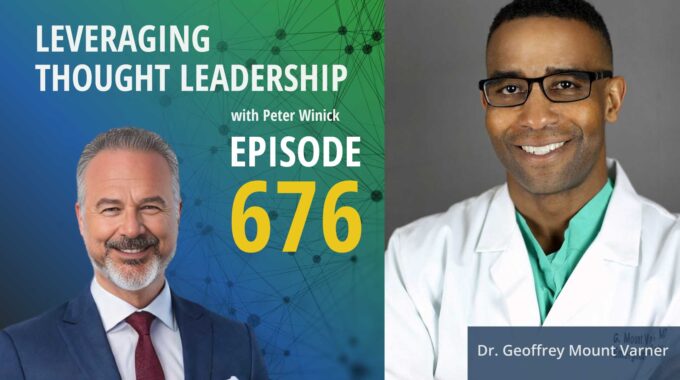A roadmap for leaders who want to multiply their impact — not their workload. This…
From Resistance to Momentum: Rethinking Organizational Change | Greg Satell

What every executive needs to know about leading through resistance
This episode explores why traditional change management falls short and how lasting transformation requires a movement mindset. You’ll learn about tools for identifying resistance, creating internal evangelists, and aligning culture with strategy.
What if you could lead organizational change the same way revolutions overthrow regimes?
Today on Leveraging Thought Leadership, Peter Winick sits down with Greg Satell—co-founder of ChangeOS, bestselling author of “Cascades: How to Create a Movement That Drives Transformational Change”, and one of the world’s top experts on transformational change. Greg doesn’t just talk about change—he’s lived through it, from leading media organizations during the Orange Revolution in Ukraine to building practical frameworks used by today’s largest corporations.
Greg shares why traditional change management often fails and how organizations can instead harness the power of movements. Drawing from real-world revolutions and network science, he explains why resistance is predictable, why change requires collective action, and how to create sustainable, culture-driven transformation that sticks.
He also breaks down the tools and models behind his work—like the Resistance Inventory and Cultural Trigger Mapping—and why building evangelists inside your organization is critical to long-term success. If your team is struggling with change fatigue, inertia, or lack of alignment, Greg’s insights offer a radically different way forward.
This episode is packed with sharp, actionable frameworks for CEOs, CHROs, transformation leaders, and fellow thought leaders alike. If you’re looking to drive change that actually lasts—this conversation is a must-listen.
Three Key Takeaways
Change is a people problem, not just a strategy problem. Successful transformation requires shifting beliefs and behaviors—not just processes or structures.
Resistance is predictable—and manageable. Most change initiatives fail because they don’t identify or plan for resistance. A resistance inventory helps leaders anticipate and navigate pushback.
Lasting change spreads like a movement. True transformation requires internal evangelists who influence their networks, making the change sustainable beyond any one leader or initiative.
If Greg’s episode sparked your interest in how movements drive lasting change, you’ll want to explore our conversation with Urvashi Bhatnagar on Implementing Niche Solutions at Scale. Both episodes dive into the challenge of turning big ideas into sustainable results—whether it’s building cultural momentum for transformation or scaling specialized solutions across complex organizations. Urvashi’s insights on aligning niche innovations with organizational structures complement Greg’s frameworks for overcoming resistance and creating internal evangelists. Together, these episodes offer a powerful blueprint for leaders who need to drive change that sticks and scales.
Transcript
Peter Winick Welcome, welcome, welcome. This is Peter Winick, I’m the founder and CEO at Thought Leadership Leverage, and you are joining us on the podcast, which is Leveraging Thought Leadership. Today, my guest is Greg Sattel. He is the co-founder of Change OS, a transformation and change advisory. He’s an international keynote speaker. He’s the host of a cool podcast, which is the Changemaker Mindset podcast and the bestselling author of Cascades: How to Create a Movement that Drives Transformational Change. And his book prior to that was Mapping Innovation. He’s also a guest lecturer at Wharton and has contributed to 50 HBR articles. So a classic underachiever and I could sit here and tell you more and more about him, but I’d rather just talk to Greg. So welcome aboard, Greg.
Greg Satell Good to see you, Peter.
Peter Winick So tell us, tell me a little bit about your journey. How did, how did all this happen? How’d you get here? Because it’s an interesting story and is in most cases it’s not a typical linear thing.
Greg Satell Yeah, not, not at all. I started off working in media in, in New York. Uh, I was selling national radio and I, I got this offer to go work in Poland, uh, selling ad space there. So I’d been in an, an athlete in college. I was a wrestler in college and so I’d never been able to do a semester abroad and I figured. “Well, the guy in the office next to me, you know, is a little older, makes a little bit more money, and has a longer commute. Other than that, he’s pretty much doing the same thing I’m doing.”
Peter Winick Right, right.
Greg Satell I might as well, I’ll go out there for six months and, you know, have a little of adventure and, you know.
Peter Winick Well, let me get this, like, certain markets are always thought to be the hot market. You go to Miami or Austin, whatever. Was Poland on the dream list of where to go to sell radio advertising back in the day? Did I miss something?
Greg Satell No, it was actually a, so it was a, it was so much a business journals, uh, that two American guys started after the fall of the Berlin wall, they, they started a colleague years earlier and so the options were, uh, they had business journals in, in Prague, in Budapest and in Warsaw and out of the three Warsaw was probably my fourth choice.
Peter Winick So you got your fourth choice. Okay.
Greg Satell I got my fourth choice and I got there and I just loved it from almost the first day it was so exciting and I didn’t realize how lucky I was to go to Poland because Poland is by far, I mean, today anybody who’s, who’s spent any time in Europe knows that Poland is essentially the capital of Eastern Europe. Yeah. By far the biggest company country, by far, the biggest economy. And the, the level of competition there is the level of professionalism is quite high. Even by European standards. When you go to Warsaw, you need to feel like you’re going to Frankfurt or to London, you’re not.
Peter Winick You go there for six months and then you stay there while you go there thinking this will be there.
Greg Satell Here I am. At this moment in history where everything is changing and everybody knew it. I mean, you wouldn’t, you have an entire country being rebuilt from the Marriott Hotel. Very well. No Class A office space, so any company that wanted to start a business there, and we’re talking about pretty much every Fortune 500 company, they. The only place they could go, they would send executives, they would stay in the Marriott, they would get an office at the Regis Center. Which, for those of you who don’t know, that was, we work before Silicon Valley.
Peter Winick Right.
Greg Satell And so you would eat in the Mariott, you would at their restaurants, you’d go to the fitness club there, and you’d got to the nightclub. And everybody you needed to do business was doing the same thing.
Peter Winick That was pretty easy, okay. You stay there, and then where does the siege or the birth of Greg the Thought Leader, the author, the academic, the cascade guy, how does, how?
Greg Satell So I ended up staying there 15 years, six in Poland, eight on and off in Ukraine, and a little bit in Russia, a little in Istanbul.
Peter Winick Okay.
Greg Satell And in 2004, I was leading a major news organization. It was a media company, but one of our biggest businesses was, was news. Drew and the orange revolution and that, that had a deep impression on me. And it was one of those moments that the universe kind of opens itself up and reveals a bit of itself to you. And what I realized was this power didn’t work the way I thought it did. You know, here we’re in a situation with no, nobody with any conventional form of power at any ability to shape events at all, there was just this mysterious force that was moving things along. And I remember even then thinking I’d like to bottle that force somehow, right? Here I was running, uh, you know, organization of 800 people…
Peter Winick But geopolitically and in the historical perspective, you’re at a moment in time, at a place, in time where things pretty special are going on and yeah and you’re looking at like you’re of deconstructing how does this happen right like kind of as you’re watching it happen.
Greg Satell No I wasn’t deconstructed.
Peter Winick Okay.
Greg Satell I was just like everybody else blindsided like what the hell just happened. I had no idea. I just knew there was something there. I couldn’t describe it. Everybody did. I mean you can’t be there without feeling what that was um and it was like nothing I’d ever experience before even I’d been in the region, what was it that was like seven years at that time. So I was fluent in the language of the culture. I’d seen a lot of upheaval, but nothing like this. And I had this thought like, what if I could bottle this force and put it to some useful purpose? You know, I was running a 800 person company and young bright people all with their own ideas. How do I get them all going in the same direction on what the things I think need to be prioritized. I had no idea how to do that. Two years later, I’m taking a publishing course out at Stanford. So I’m in Silicon Valley for a few weeks. Everybody’s talking about social network. And that’s when Facebook was just really Becoming a thing, and we had a, we also had a very big digital business. So I said, this is something I should really learn about. So I started researching network science and the, uh, especially the work of Duncan Watts, and here was a mathematical explanation for almost everything that happened during the orange revolution. So now I was hooked and I started researching deeper about movements, about social networks. And then when the world was blowing up in 2009, and we sold Arble to Petro Poroshenko, who would become the president of Ukraine, I was looking around for something to do. So while I did that, I, I started my blog and then that took off, got picked up by Forbes and Harvard business review, and eventually I came back here and this whole time now starting to write about it and, and these experiences into some coherent form. While I’m doing that, I run in, I meet this guy, Serja Popovic, who was the architect of the color revolutions. He led the movement that overthrew Milosevic and then trained the guys in, in the Rose revolution in Georgia, and then the Orange revolution. Right. And he had built this and more than 50 countries since then, and he’s become a close friend. And he had built this repeatable model for overthrowing a country. And I did quite a bit of organizational transformation when I was in, you know, in 15 years of Eastern Europe. And this seems to me like it would be a great model for organizational transformation.
Peter Winick Okay. So now…
Greg Satell It’s the research that became cascades.
Peter Winick Right. So you took. What you were observing, right? You were living it, you’re observing it, you’re part of it, it’s there. And then you’d make that bridge, because this is where that, the interesting things happen at the seams, right. There’s geopolitical change up as the people, this, that, and the other thing. And you’re like, ah, this actually connects to how organizations go through change and issues and pieces. And that’s really, when people think of you today, they think of more as the org cascade guy than the observer of geopolitical revolutionary things.
Greg Satell Or the media guy, we’re the publisher, or any of those things. But one thing, and I try and be very clear about this in writing the book. In the book, I had no idea. There wasn’t this moment of epiphany where a light gone on. There was just this feeling of extreme confusion. About something that happened that I knew was important, but I had no idea how to make sense of it much less, much less communicate to others. And that was a very, very long hard process.
Peter Winick If you’re enjoying this episode of Leveraging Thought Leadership, please make sure to subscribe. If you’d like to help spread the word about our podcast, please leave a five-star review at ratethispodcast.com/LTL and share it with your friends. We’re available on Apple podcasts and on all major listening apps, as well as at thoughtleadershipleverage.com/podcast.
Peter Winick So now organizations are bringing you in to, so fill in the blank. I get paid to do X for Y. Like who’s bringing you into get what done based on.
Greg Satell They’re bringing me in to help them build a change strategy around an initiative that it’s important to their business, whether that is a cultural change or a technology change. Often, I partner with other thought leaders.
Peter Winick Is this a new variation on change management? Or is it?
Greg Satell Change management is, is, is much different. And, and this is a, when you’re talking about change management and methodologies, like ADKAR, Kotter, you’re really talking about internal communication and training you’re talking about solving a communication and coordination problem. Here’s a change. It’s going to happen. That decision has been made. I always say the classic one is at Intel when they made that famous move out of memory chips. Yeah, it’s the CEO says our factories are changing over. That’s going to happen It doesn’t it doesn’t matter what anybody thinks about it, right?
Peter Winick But most of them they burn they burn the boats, right.
Greg Satell Yeah, most of the changes and they have full authority to make the change but back then back in the 80s when all these change management, 80s and 90s really, when these change management methodologies were being designed. More than 80% of corporate assets were tangible assets. So yeah, most changes were strategic changes today. Most, you know, more than 90% of strategic ad assets or excuse me, corporate assets are intangible assets, know how licenses. So when we talk about change today, we’re talking about change, changes in what people think and what they do.
Peter Winick And you’re not optimized to…
Greg Satell Changes require collective action. And they’re very sensitive to resistance.
Peter Winick Right. So you’re not, that’s why they often fact, a factor where you have control over the hardware, this is really the, the software, if you will, where you’re going to get the resistance. So when organizations are bringing you into shepherd them through this. What are the various ways that you do that? There’s speaking, advising code.
Greg Satell Like, oh, first of all, day one. We have a tool called the resistance inventory, where we analyze that and build strategies and anticipate from day one, where that resistance is going to come from. Okay. That’s something that usually, to be honest, almost never gets done. And when you look at change management methodologies like ADKAR, they don’t have a methodology for, for dealing with resistance. So that’s the first.
Peter Winick So you start with the tool. Then what?
Greg Satell Well, then we, there’s a suite of tools. So we have one for resistance, one for cultural triggers, one for stakeholder analysis, almost all built on this original methodology design, thought up by a guy named Gene Sharp, and then built into practice by Sir John.
Peter Winick It’s not dependent on you specifically. The tools could be administered by others. So there’s some scale and leverage built into the model, right? It’s that there are others that could, that could deploy these tools.
Greg Satell Right. And usually I’m partnering with another thought leader. So for instance, I have one friend who does gender intelligence, right. So she generally gets hired when a big corporation gets sued. Or they have, or have some high profile people. Right. Right. So she comes and she has a great methodology, great assessment tool. And she comes, she comes. And helps them fix the problem. And then five years later, they call her again, because it never took hold. Right. They say, so all the, and it went back. The best indicator of things that we think and do are what the people around us think and do. So even if we’re, if, if somebody’s convinced, once they get back embedded in those networks, they’re going to get convinced right back, this is a frustration among a lot of successful thought leaders is they go in, they help people understand the changes they need to make some initial successes are done, but a year or two later, they’re right back where they started.
Peter Winick Yeah. So stay, stay there for a minute because that to me is the issue of sustainability, right? Cause it’s one thing to set to come in and say, I can go in, roll up my sleeves, be a good consultant, diagnose the problem, put together a slick report, talk to management, senior leadership. Here’s the problem, here’s the data to support it quantitatively, qualitatively. Senior leadership goes, okay, cool. I see it’s a problem, help me fix it. And then you say, well, here is what we’re going to do first, right? That’s six months, a year, whatever. And then we go our separate ways, but that sustainability piece, if you’re not changing capabilities, if you’re not changing culture, if they’re not changing a whole bunch of other things, guess what, like you said, whether it’s two years, five years, whatever the weeds are going to come back up, right.
Greg Satell Yes. And here we have this huge problem at this one division. Let’s go in, we fix the problem, big success. That guy gets hired away and then it goes back and the rest of the company, the rest, the organization never got touched because that was just the problem with the guy in the Northeast or something like that.
Peter Winick Who’s now working at your competitor or whatever the case might be.
Greg Satell Exactly.
Peter Winick So I think a lot of thought leaders. Miss the opportunity to work backwards and stay, I’m going to develop a set of an extension of my thought leadership that deals with the sustainability piece. Because that’s really, I think most senior leaders have been through the diagnose the problem, do some consulting, do the front end, and then ha ha ha three, four years later, I’ll see you in a little bit, right? Like, how do you get to the root?
Greg Satell That and that and I call it the day after agile training. Where, where you’re going and you’re, you’re training somebody. You’re giving them a skill. You’re given them a tool. Right. And you’re a thought leader and that’s great. And it works for them and everything. But they’re not being good evangelists because we know what happens the day after and agile training, you send that guy super or that girl super enthusiastic. They go and they expect everything to change at once. And then when it doesn’t, they get frustrated and then they, you know, all sorts of bad things happen. And this is another reason why I like other thought leaders partner with me is because. Ideally you want that executive that you’ve helped to then go be an evangelist for you in that organization.
Peter Winick Internally. So you…
Greg Satell Internally, so they become your best sales people, not the people getting shut on and, and sort of, so we lend your name just because they’re excited about your work.
Peter Winick Well, and at that moment in time, inside the organization, they’re typically most favored nation. They’re a favorite child. Look at what they did. Look at how they’re doing it. So now the other divisions, whether that’s, that’s functional geographical going. Wow, so-and-so over here did some cool stuff, what’s going on there? As we start to wrap, Greg, any thoughts or recommendations for others out there that might be on the cusp of saying, yeah, this thought leadership thing, I think I wanna be that. It wouldn’t be go to Poland for six months and stay for 15 years, I imagine. I
Greg Satell think it is the best ideas don’t automatically win. It took me 15 years to go from that initial, Hey, what’s that to, to cascades and even longer to, really build it into a practice. So you’ll have an idea that you’re excited about. You need to understand that people are not going to understand and adopt it in the form, in the same form in which you came to understand. And that’s how you need to serve, build that bridge. I love that. Well, this has been great. I appreciate your time. And I am not.
Peter Winick I love this story and the origin story and then the application and the bridging from sort of the geopolitical into the organizational. So thanks for sharing, Greg.
Greg Satell Thanks for having me on.
Peter Winick To learn more about Thought Leadership Leverage, please visit our website at ThoughtLeadershipLeverage.com. To reach me directly, feel free to email me at peter at Thought Leadership leverage.com and please subscribe to Leveraging Thought Leadership on iTunes or your favorite podcast app to get your weekly episode automatically.





